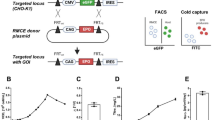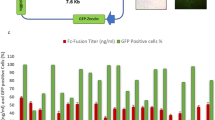Abstract
Several engineering strategies have been employed to improve the production of therapeutic recombinant proteins in Chinese hamster ovary (CHO) cell lines. We have focused on unfolded protein response-based engineering and reported that ATF4 overexpression increases protein production. In this study, transcriptome analysis of ATF4-overexpressed CHO cells was performed using high-coverage expression profiling, to search for another key factor contributing to recombinant protein production. We observed the upregulated expression of transcription factor, nuclear factor (NF)-kappa-B inhibitor zeta (NFKBIZ or Iκbζ), in ATF4-overexpressed cells. A total of 1917 bp of CHO NFKBIZ cDNA was cloned, and two stable cell lines overexpressing NFKBIZ were constructed. We investigated the effects of NFKBIZ on IgG1 production in CHO cells. Although the two stable cell lines, NFKBIZ-A and -B, had the opposite phenotypes in cell growth, the specific IgG1 production rate of both cell lines was enhanced by 1.2–1.4-fold. In the NFKBIZ-A cell line, the synergistic effect between enhanced viable cell density and improved specific IgG1 production rate brought about a large increase in the final IgG1 titer. Luciferase-based NF-κB signaling assay results suggest that altered p50/p50 signaling seems to be due to the opposite phenotypes in cell growth. No difference was observed in the translational levels and intracellular assembly states of IgG1 between mock and two NFKBIZ cell lines, indicating that the secretion machinery of correctly folded IgG1 was enhanced in NFKBIZ-overexpressing cell lines.




Similar content being viewed by others
References
Barken D, Wang CJ, Kearns J, Cheong R, Hoffmann A, Levchenko A (2005) Comment on “Oscillations in NF-kappaB signaling control the dynamics of gene expression”. Science 308:52 author reply 52
Becker E, Florin L, Pfizenmaier K, Kaufmann H (2008) An XBP-1 dependent bottle-neck in production of IgG subtype antibodies in chemically defined serum-free Chinese hamster ovary (CHO) fed-batch processes. J Biotechnol 135:217–223
Brown AJ, Sweeney B, Mainwaring DO, James DC (2014) Synthetic promoters for CHO cell engineering. Biotechnol Bioeng 111:1638–1647
Brown AJ, Sweeney B, Mainwaring DO, James DC (2015) NF-kappaB, CRE and YY1 elements are key functional regulators of CMV promoter-driven transient gene expression in CHO cells. Biotechnol J 10:1019–1028
Cacciatore JJ, Chasin LA, Leonard EF (2010) Gene amplification and vector engineering to achieve rapid and high-level therapeutic protein production using the Dhfr-based CHO cell selection system. Biotechnol Adv 28:673–681
Datta P, Linhardt RJ, Sharfstein ST (2013) An’omics approach towards CHO cell engineering. Biotechnol Bioeng 110:1255–1271
Feger F, Dubart A, Lacout C, Dusanter-Fourt I, Mayeux P, Vainchenker W, Dumenil D (1997) Ectopic expression of the erythropoietin receptor in a murine interleukin-6-dependent plasmacytoma cell line (TEPC-2027) confers proliferative responsiveness to erythropoietin. Blood 89:435–445
Fischer S, Handrick R, Otte K (2015) The art of CHO cell engineering: a comprehensive retrospect and future perspectives. Biotechnol Adv 33:1878–1896
Fukumura R, Takahashi H, Saito T, Tsutsumi Y, Fujimori A, Sato S, Tatsumi K, Araki R, Abe M (2003) A sensitive transcriptome analysis method that can detect unknown transcripts. Nucleic Acids Res 31:e94
Ghosh G, Wang VY, Huang DB, Fusco A (2012) NF-kappaB regulation: lessons from structures. Immunol Rev 246:36–58
Haredy AM, Nishizawa A, Honda K, Ohya T, Ohtake H, Omasa T (2013) Improved antibody production in Chinese hamster ovary cells by ATF4 overexpression. Cytotechnology 65:993–1002
Hasegawa H, Wendling J, He F, Trilisky E, Stevenson R, Franey H, Kinderman F, Li G, Piedmonte DM, Osslund T, Shen M, Ketchem RR (2011) In vivo crystallization of human IgG in the endoplasmic reticulum of engineered Chinese hamster ovary (CHO) cells. J Biol Chem 286:19917–19931
Hussain H, Maldonado-Agurto R, Dickson AJ (2014) The endoplasmic reticulum and unfolded protein response in the control of mammalian recombinant protein production. Biotechnol Lett 36:1581–1593
Khan SU, Schroder M (2008) Engineering of chaperone systems and of the unfolded protein response. Cytotechnology 57:207–231
Kildegaard HF, Baycin-Hizal D, Lewis NE, Betenbaugh MJ (2013) The emerging CHO systems biology era: harnessing the ‘omics revolution for biotechnology. Curr Opin Biotechnol 24:1102–1107
Li F, Vijayasankaran N, Shen AY, Kiss R, Amanullah A (2010) Cell culture processes for monoclonal antibody production. MAbs 2:466–479
Ma Y, Hendershot LM (2004) The role of the unfolded protein response in tumour development: friend or foe? Nat Rev Cancer 4:966–977
Makishima F, Terada S, Mikami T, Suzuki E (1992) Interleukin-6 is antiproliferative to a mouse hybridoma cell line and promotive for its antibody productivity. Cytotechnology 10:15–23
Motoyama M, Yamazaki S, Eto-Kimura A, Takeshige K, Muta T (2005) Positive and negative regulation of nuclear factor-kappaB-mediated transcription by IkappaB-zeta, an inducible nuclear protein. J Biol Chem 280:7444–7451
Nelson DE, Ihekwaba AE, Elliott M, Johnson JR, Gibney CA, Foreman BE, Nelson G, See V, Horton CA, Spiller DG, Edwards SW, McDowell HP, Unitt JF, Sullivan E, Grimley R, Benson N, Broomhead D, Kell DB, White MR (2004) Oscillations in NF-kappaB signaling control the dynamics of gene expression. Science 306:704–708
Ohya T, Hayashi T, Kiyama E, Nishii H, Miki H, Kobayashi K, Honda K, Omasa T, Ohtake H (2008) Improved production of recombinant human antithrombin III in Chinese hamster ovary cells by ATF4 overexpression. Biotechnol Bioeng 100:317–324
Omasa T, Higashiyama K, Shioya S, Suga K (1992) Effects of lactate concentration on hybridoma culture in lactate-controlled fed-batch operation. Biotechnol Bioeng 39:556–564
Omasa T, Takami T, Ohya T, Kiyama E, Hayashi T, Nishii H, Miki H, Kobayashi K, Honda K, Ohtake H (2008) Overexpression of GADD34 enhances production of recombinant human antithrombin III in Chinese hamster ovary cells. J Biosci Bioeng 106:568–573
Omasa T, Onitsuka M, Kim WD (2010) Cell engineering and cultivation of chinese hamster ovary (CHO) cells. Curr Pharm Biotechnol 11:233–240
Onitsuka M, Omasa T (2015) Rapid evaluation of N-glycosylation status of antibodies with chemiluminescent lectin-binding assay. J Biosci Bioeng 120:107–110
Pahl HL, Baeuerle PA (1997) The ER-overload response: activation of NF-kappa B. Trends Biochem Sci 22:63–67
Pybus LP, Dean G, West NR, Smith A, Daramola O, Field R, Wilkinson SJ, James DC (2014) Model-directed engineering of “difficult-to-express” monoclonal antibody production by Chinese hamster ovary cells. Biotechnol Bioeng 111:372–385
Takagi Y, Yamazaki T, Masuda K, Nishii S, Kawakami B, Omasa T (2017) Identification of regulatory motifs in the CHO genome for stable monoclonal antibody production. Cytotechnology 69:451–460. https://doi.org/10.1007/s10616-016-0017-8
Tigges M, Fussenegger M (2006) Xbp1-based engineering of secretory capacity enhances the productivity of Chinese hamster ovary cells. Metab Eng 8:264–272
Totzke G, Essmann F, Pohlmann S, Lindenblatt C, Janicke RU, Schulze-Osthoff K (2006) A novel member of the IkappaB family, human IkappaB-zeta, inhibits transactivation of p65 and its DNA binding. J Biol Chem 281:12645–12654
Van Snick J (1990) Interleukin-6: an overview. Annu Rev Immunol 8:253–278
Wietek C, O’Neill LA (2007) Diversity and regulation in the NF-kappaB system. Trends Biochem Sci 32:311–319
Wurm FM (2004) Production of recombinant protein therapeutics in cultivated mammalian cells. Nat Biotechnol 22:1393–1398
Yamamoto M, Yamazaki S, Uematsu S, Sato S, Hemmi H, Hoshino K, Kaisho T, Kuwata H, Takeuchi O, Takeshige K, Saitoh T, Yamaoka S, Yamamoto N, Yamamoto S, Muta T, Takeda K, Akira S (2004) Regulation of Toll/IL-1-receptor-mediated gene expression by the inducible nuclear protein IkappaBzeta. Nature 430:218–222
Yamazaki S, Muta T, Matsuo S, Takeshige K (2005) Stimulus-specific induction of a novel nuclear factor-kappaB regulator, IkappaB-zeta, via Toll/Interleukin-1 receptor is mediated by mRNA stabilization. J Biol Chem 280:1678–1687
Acknowledgements
The authors would like to thank Dr. Tomoshi Ohya (Mitsubishi Tanabe Pharma) for his valuable discussions. This research was partially supported by developing key technologies for discovering and manufacturing pharmaceuticals used for next-generation treatments and diagnoses from the Ministry of Economy, Trade and Industry, Japan (METI) and from the Japan Agency for Medical Research and Development (AMED).
Author information
Authors and Affiliations
Corresponding author
Electronic supplementary material
Below is the link to the electronic supplementary material.
Rights and permissions
About this article
Cite this article
Onitsuka, M., Kinoshita, Y., Nishizawa, A. et al. Enhanced IgG1 production by overexpression of nuclear factor kappa B inhibitor zeta (NFKBIZ) in Chinese hamster ovary cells. Cytotechnology 70, 675–685 (2018). https://doi.org/10.1007/s10616-017-0170-8
Received:
Accepted:
Published:
Issue Date:
DOI: https://doi.org/10.1007/s10616-017-0170-8




